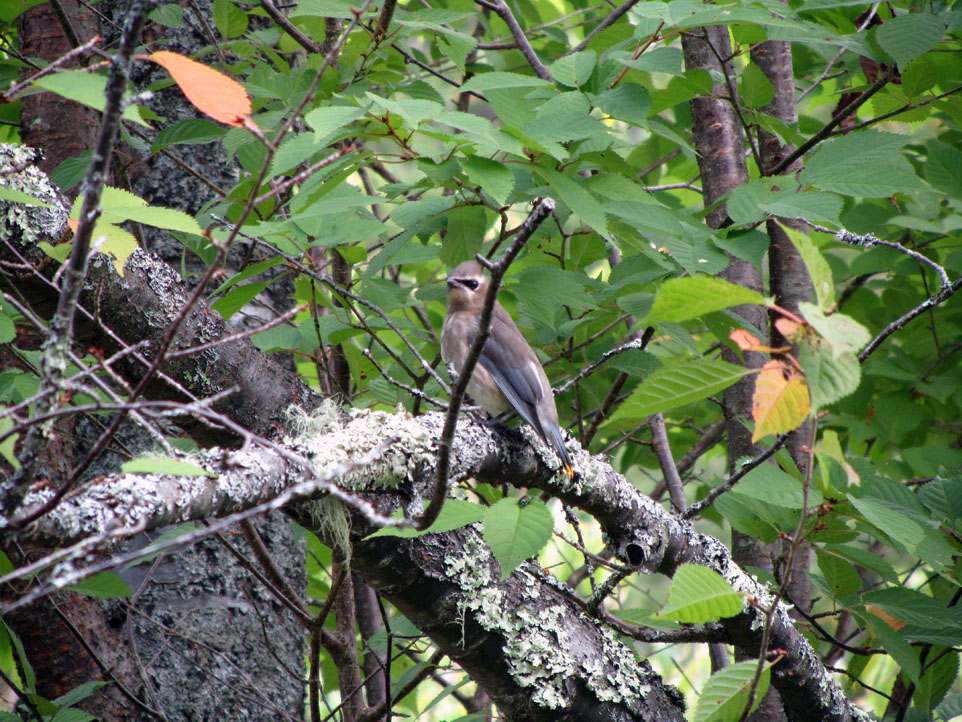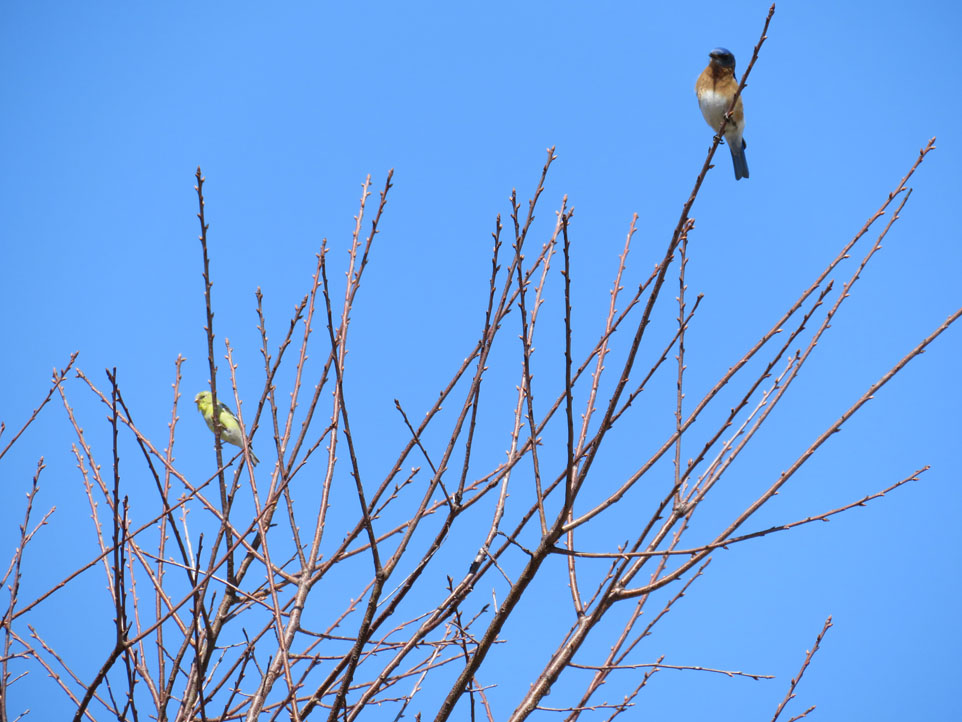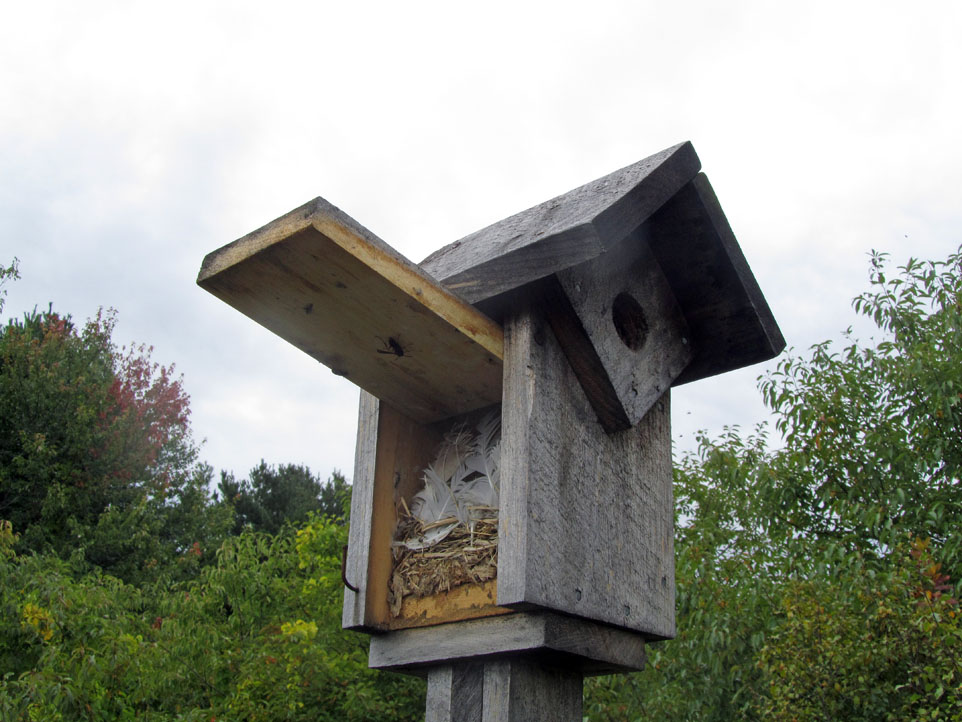
Gardening is for the Birds!
Article and Photographs by Amy Witt, UMaine Extension Horticulturist
Gardens bring delight to gardeners, visitors, and people passing by. They can also provide important habitat for birds, and in return, more enjoyment for the gardener and visitors.
Gardening successfully for birds involves meeting their basic needs of food, water, nesting sites and shelter.

Plan & Plant
The first step in designing a bird garden is to evaluate your yard from a bird’s perspective. Does it provide for their basic needs? If not, what is lacking?
To give you a sense of the types of plants and plant communities that make up the natural bird habitat in your area, visit various local parks and wildlife sanctuaries. Notice the plants and their habit – are there vertical and horizontal layers; large masses or groupings? Creating a similar environment using native plants is an important step to a successful bird garden.
Begin planning your garden by completing an inventory of your property (include plants, habitats, birds, structures, also take note what is on adjacent properties). Next, create a map of your property or the space where you want the garden to be. Sketch in your house, fences, out buildings, driveway, utilities and all of your existing plants (trees, shrubs, herbaceous plants) – noting which ones benefit the birds. This map will be a good tool for you to identify the existing resources for attracting birds. Once you have your inventory and map, it’s time to start designing your garden.
When designing your garden, keep the following in mind:
- Full sun means more food (there are more varieties of fruit and nut trees that prefer full sun than shade)
- Create vistas (birds need to be able to survey their surroundings for food and predators)
- Vary heights of vegetation (birds perch, nest and forage for food at different heights)
- Planting thickets or groupings of plants is more desirable to birds than having single plants scattered across an area
- Create a natural effect (nature doesn’t plant in a straight lines, curves and clusters are very appealing to birds)
- Establish plantings for year-round beauty, shelter and food
- Use diverse living (plants) & non-living (structures) materials
- Use native plants as much as possible
- Remove invasive plants (many invasive plants out-compete the native species favored by birds)
- Reduce your lawn area (lawns have little value to birds)
- Do not use pesticides (remember, insects are the primary source of food for many birds)
Meeting the Basic Needs
Food
Native plants provide the best food sources for birds. Try to recreate the plant ecosystem native to your area by selecting a variety of plants that offer year-round food in the form of seeds, berries, nuts, buds, nectar and insects. Native insects evolved to feed on native plants, and birds raise their young on insects.
Different birds require different kinds of foods in different seasons. While raising their young, adult birds get the energy they need from sweet fruits (e.g. berries and wild cherries); fall migrating birds require fatty fruits (e.g. flowering dogwood and spicebush) to build fat reserves; and wintering birds need abundant, persistent fruits (e.g. conifers, bayberry, crabapples, and sumacs) to help them survive winter temperatures. Persistent fruits are also extremely important for early spring migrating birds.
Supplemental feeders can also be used, particularly if there is shortage of natural food. Add variety to the kinds of food you offer, and you’ll attract a wider variety of bird species. Use suet only from October through April or May (sun-warmed suet can cause infected follicles and loss of facial feathers). To protect the birds from predators (like cats), place feeders 10 feet from cover (i.e. dense shrubs and buildings)

Water
While birds get much of the water they need from foods, they will also use open water sources such as birdbaths, ponds and water gardens, for drinking and bathing. Birds need access to water all year long, especially for cooling themselves in summer’s heat and during the winter when ponds, lakes and streams are frozen or covered with snow.
When choosing a birdbath, find one with a shallow slope (no deeper than 3”), as most birds have short legs and avoid deep water. Place the birdbath about 10 feet from dense shrubs or other cover that predators may use.
It is a good idea to clean the bath with a stiff brush every few days and add fresh water as needed. Birds will drink from the bath as well as bathe, and excrement and algae can accumulate when baths are neglected. To make sure the birdbath is accessible year round, add a heater in the winter.
Nesting Sites
It’s a bonus if your garden and adjacent property can provide appropriate and adequate nesting sites for your backyard birds.
Does your yard have an area of dense thickets that birds could use for nesting, secluded perching, or escape cover? If not, you can easily provide an area by planting and grouping dense shrubs or making a hedge.
What about dead trees? Dead trees not only provide cavities for birds to raise their young, they also contain a lot of insects for the birds to feed on.
Some birds will nest in brush piles, so think about creating a brush pile in a corner of your yard. Start with larger logs for the base and add smaller branches to the top.
Nesting boxes are also a great addition. Keep in mind that nesting boxes are species specific. If you want to put out a box for bluebirds, make certain it is a box designed for bluebirds. Nesting boxes need to have ventilation holes at the top and drainage holes on the bottom. Do not use a box with a perch, as house sparrows are known to sit on the perch and peck at other birds using the box. Nesting boxes should have a side panel that opens so the inside of the box is easily accessible and can be cleaned out. Lastly, place nesting boxes out of reach of cats, raccoons and other predators. Placing a baffle on the pole directly under the box is also a good idea.
Shelter
Providing shelter is different than providing a nesting site. Birds need places where they can hide from predators and inclement weather.
Evergreen trees and shrubs provide excellent cover through all seasons. Many birds will also seek shelter from bad weather inside hollowed out trees, brush piles and rock walls.
You can also set-up roosting boxes. They have an entrance hole near the bottom so that heat doesn’t escape. Mount the box in a sheltered area, preferably facing south.

Other things you can do to attract birds to your yard:
- Don’t deadhead flowers in the fall; many birds will eat the dried seed heads.
- Leave the leaves alone rather than raking leaves in the fall and taking them to the dump, use them to create feeding places for birds. Place the leaves in 5-6” piles under trees and shrubs. By spring the leaves will have decomposed and attracted earthworms, insects, and other animals on which the birds feed.
- Create a dust bath; many birds, take dust baths to control external parasites. A dusting site can be a dirt driveway or a circle of finely pulverized soil 2 feet across.
- Leave a few dead branches on live trees for perches. Birds tend to perch on dead branches, which they use as singing posts to defend their territories.
- Provide nesting material in the spring including small twigs, mud, moss, dried grass stems, wool, hair (avoid using hair from animals that have been treated with pesticides, such as flea and tick spray), snakeskins, narrow strips of cloth, string and yarn. DON’T USE laundry dryer lint. It will soak up water and may be steeped with chemicals unhealthy for birds.
